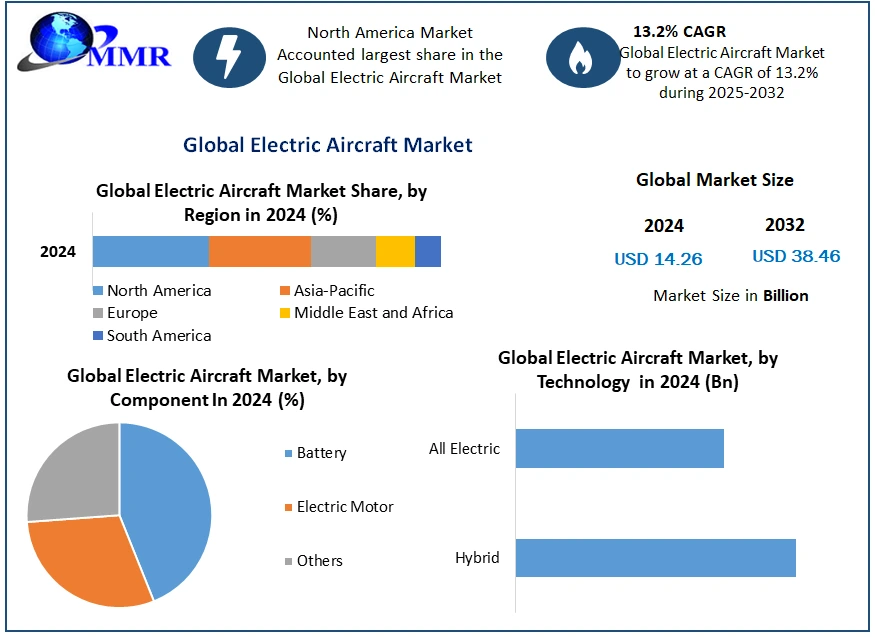
Introduction
The aviation industry is on the brink of a transformative era with the advent of electric aircraft. As the world gravitates towards sustainable solutions, electric aviation emerges as a beacon of hope, promising reduced emissions, decreased noise pollution, and enhanced operational efficiency. This article delves into the current landscape of the electric aircraft market, highlighting its growth trajectory, key drivers, challenges, and future prospects.
Market Overview
In 2024, the Electric Aircraft Market was valued at approximately USD 14.26 billion. Projections indicate a robust growth, with the market expected to reach nearly USD 38.46 billion by 2032, reflecting a compound annual growth rate (CAGR) of 13.2% from 2025 to 2032.
If you’re interested in obtaining a sample of the report, please visit the request sample page:https://www.maximizemarketresearch.com/request-sample/11055/
Segmentation Insights
The electric aircraft market can be dissected based on various parameters:
-
Aircraft Type:
-
Ultra-light Aircraft: These are primarily used for recreational purposes and pilot training.
-
Light Jets: Designed for short-haul commercial flights and personal use.
-
-
Component:
-
Battery: Serving as the primary power source, advancements in battery technology are pivotal for market growth.
-
Electric Motor: Responsible for converting electrical energy into mechanical thrust.
-
Others: Includes auxiliary systems and control units.
-
-
Technology:
-
Hybrid: Combines conventional fuel engines with electric propulsion.
-
All-Electric: Relies solely on electric power for propulsion.
-
-
Power Density:
-
Less than 500 KM: Suitable for short-haul flights and urban air mobility.
-
More than 500 KM: Targets regional and potentially longer routes as battery technology advances.
-
-
Application:
-
Commercial: Passenger and cargo transport services.
-
Military: Surveillance, reconnaissance, and tactical operations.
-
Key Market Drivers
Several factors are propelling the growth of the electric aircraft market:
-
Environmental Concerns: The pressing need to reduce carbon footprints has accelerated the shift towards electric propulsion systems.
-
Technological Advancements: Innovations in battery technology, such as higher energy densities and faster charging capabilities, are making electric aircraft more viable.
-
Economic Benefits: Electric aircraft promise lower operational costs due to reduced fuel consumption and maintenance requirements.
-
Urban Air Mobility (UAM): The rise of UAM concepts has spurred interest in electric vertical take-off and landing (eVTOL) aircraft for intra-city transport.
Challenges Facing the Market
Despite the optimistic outlook, the market faces certain challenges:
-
Battery Limitations: Current battery technologies still lag behind in terms of energy density compared to traditional aviation fuels, limiting range and payload capacities.
-
Infrastructure Development: Establishing charging stations and maintenance facilities for electric aircraft requires significant investment.
-
Regulatory Hurdles: The nascent nature of electric aviation means that regulatory frameworks are still evolving, potentially slowing down certification processes.
Regional Insights
North America stands out as a dominant player in the electric aircraft market. Factors contributing to this include substantial investments in research and development, a robust aviation infrastructure, and proactive governmental policies promoting green aviation initiatives.
For a comprehensive analysis and detailed insights into the electric aircraft market, you can access the full report here:https://www.maximizemarketresearch.com/market-report/electric-aircraft-market/11055/
Future Outlook
The horizon looks promising for electric aviation:
-
Emergence of eVTOLs: Companies are investing heavily in eVTOL technology, aiming to revolutionize urban transportation.
-
Collaborative Ventures: Partnerships between aerospace giants and tech companies are fostering innovation and accelerating commercialization.
-
Sustainable Aviation Fuels (SAFs): While not purely electric, the integration of SAFs with hybrid-electric systems could serve as a transitional solution towards fully electric aviation.
Conclusion
The electric aircraft market is poised at the cusp of a revolutionary shift in aviation. While challenges persist, the confluence of technological advancements, environmental imperatives, and market dynamics suggests a bright future. Stakeholders, including manufacturers, policymakers, and consumers, must collaborate to navigate this transformative journey towards sustainable skies.








ثبت نام کنکور کارشناسی ارشد سراسری، فرآیندی است که
توسط سازمان سنجش آموزش کشور به منظور پذیرش دانشجویان در مقطع کارشناسی ارشد در دانشگاههای دولتی و سایر مؤسسات آموزش عالی برگزار میشود.
ثبت نام کنکور کارشناسی ارشد سراسری،
فرآیندی است که توسط سازمان سنجش آموزش کشور به منظور پذیرش دانشجویان در مقطع کارشناسی ارشد
در دانشگاههای دولتی و سایر مؤسسات آموزش عالی برگزار میشود.
ثبت نام کنکور کارشناسی ارشد سراسری، فرآیندی است که توسط سازمان سنجش آموزش کشور به منظور پذیرش دانشجویان در
مقطع کارشناسی ارشد در دانشگاههای دولتی و
سایر مؤسسات آموزش عالی برگزار میشود.
cincin-bet
365-bet
http://mail.crn-nieruchomosci.pl/br/index.php?id=bazooka-bet
Eu vou imediatamente agarrar seu rss como eu não posso em encontrar seu email assinatura hyperlink ou serviço de e-newsletter.
Você tem algum? Por favor permita eu perceber para que eu possa assinar.
Obrigado.
70918248
References:
legal testosterone Steroids
Online poker
مای مدیو کارنامه نوبت دوم، سایت مای مدیو
کارنامه my.medu.ir برای دریافت کارنامه
نوبت اول، نوبت دوم و شهریور با کد ملی توسط وزارت
آموزش و پرورش راه اندازی شده است.
مای مدیو کارنامه نوبت دوم،
سایت مای مدیو کارنامه my.medu.ir برای دریافت کارنامه نوبت اول، نوبت دوم و شهریور با کد ملی توسط
وزارت آموزش و پرورش راه اندازی شده است.
Hi there, this weekend is good designed for me, as this moment i am reading this enormous educational paragraph here at my home.
Nailed it again! As an Albany Park roofer, we’ve cracked Chicago’s brutal “emergency HVAC” SERPs through CTA station proximity hacks + Ben’s Breadcrumb
plugin. Forget cookie-cutter audits – Chi-Town demands two-fisted review syndication across Wicker Park mom blogs.
Last month: ffor “burst pipe Rogers Park”. PS: Magnificent Mile
directory paywalls = gamechanger.
– Marcus @ Chicago one local seo (Sommer) Network
Excellent post. I was checking constantly this weblog and I’m inspired!
Extremely helpful info specifically the final part :
) I handle such info much. I used to be seeking this particular information for a very long time.
Thank you and good luck.